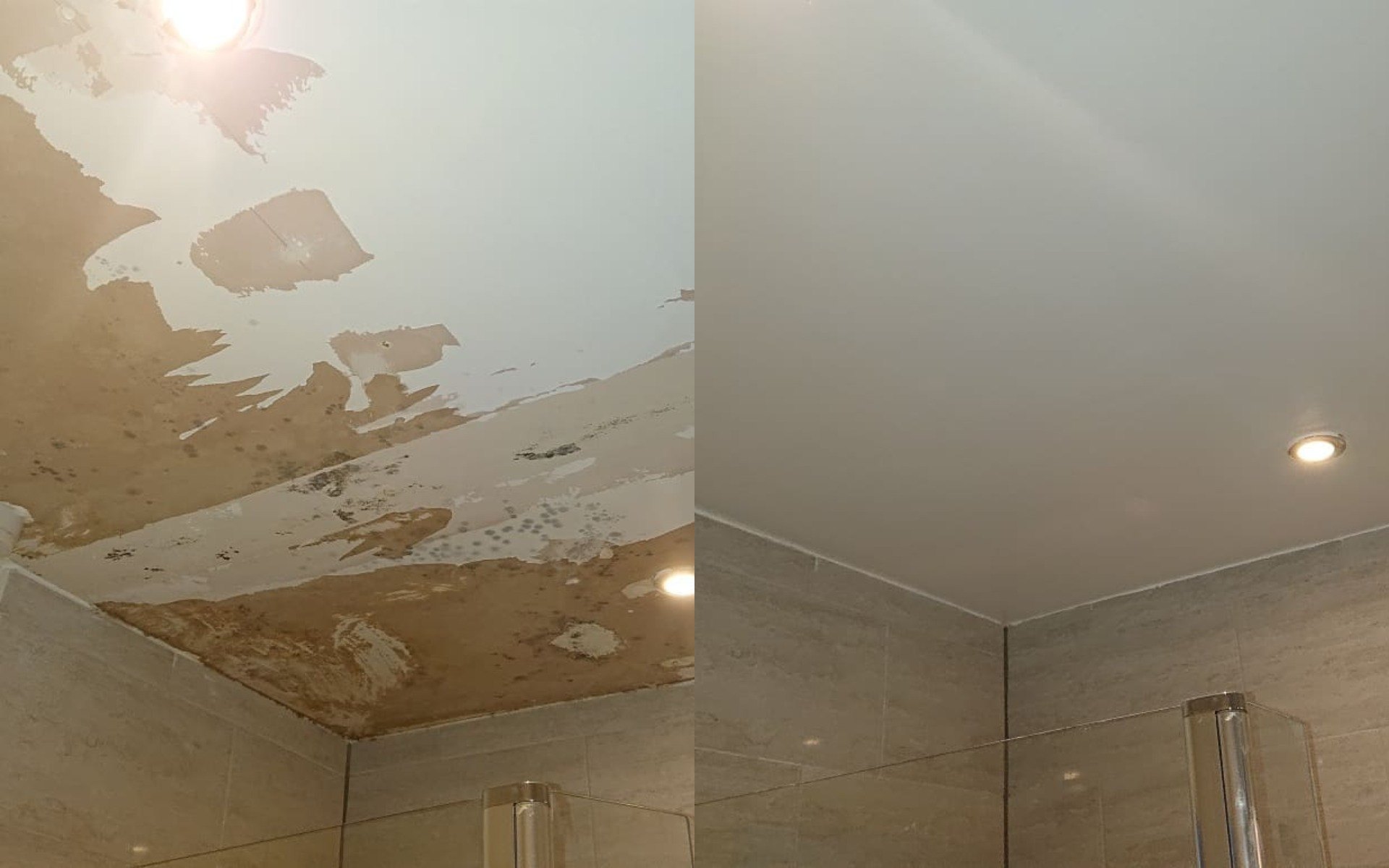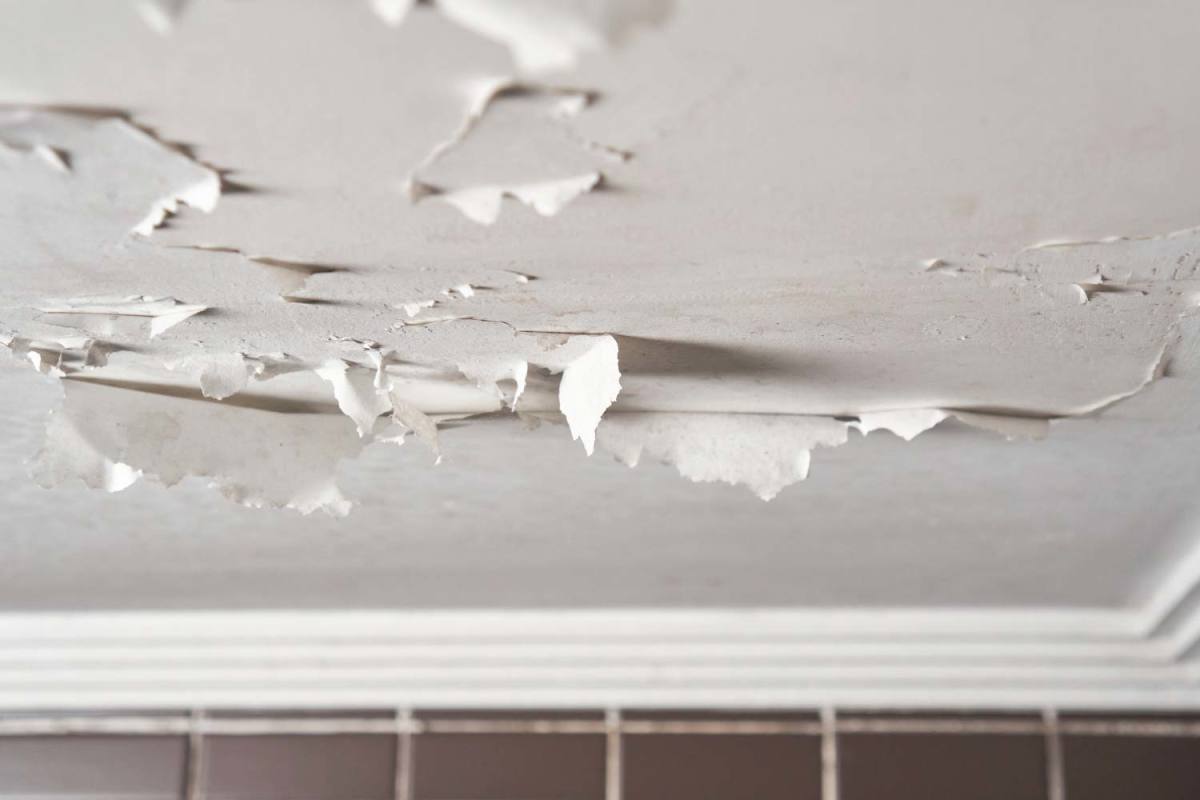Causes of Bathroom Ceiling Paint Peeling

A peeling bathroom ceiling can be an unsightly problem, and it can also be a sign of a bigger issue. While there are many factors that can contribute to paint peeling, moisture is often the culprit.
Moisture’s Role in Paint Peeling
Moisture can cause paint to peel for a few reasons. First, when moisture gets trapped behind the paint, it can cause the paint to bubble and lift. This is because water expands when it freezes, and this expansion can put pressure on the paint, causing it to crack and peel. Second, moisture can also cause the underlying surface to deteriorate, which can lead to paint peeling. For example, if the drywall is damaged by water, the paint may not be able to adhere properly.
Impact of Poor Ventilation on Bathroom Ceiling Paint, Bathroom ceiling paint peeling
Poor ventilation is a major contributor to moisture buildup in bathrooms. When there is not enough ventilation, steam from showers, baths, and even just the humidity in the air can become trapped in the bathroom. This trapped moisture can then condense on the walls and ceiling, leading to paint peeling.
Preventing Moisture Buildup in Bathrooms
- Ensure proper ventilation. This means having a fan that vents to the outside, and using it every time you shower or bathe. You should also make sure that your bathroom door is open when you are not using the room, to allow for air circulation.
- Use a dehumidifier. If your bathroom is particularly humid, you may want to use a dehumidifier to help remove excess moisture from the air.
- Fix any leaks promptly. Even a small leak can lead to moisture buildup, so it’s important to fix any leaks as soon as possible.
Identifying the Problem

Understanding the type of paint peeling and its underlying cause is crucial for effective repair. Identifying the source of the problem allows you to choose the right approach for fixing the peeling paint and preventing future issues.
Types of Paint Peeling
Different types of paint peeling indicate different causes. Here’s a breakdown:
- Flaking: This type of peeling occurs when the paint film separates from the surface in thin, brittle sheets. It often happens when the paint was applied over a dirty or oily surface, or when the paint was not allowed to dry properly between coats.
- Chipping: Paint chips are small pieces of paint that break off from the surface. This is often caused by impact damage, such as from a dropped object or a hard brush stroke.
- Blistering: Paint blisters are small, raised bubbles that appear on the surface of the paint. They are often caused by moisture trapped beneath the paint film, which can be caused by leaks, condensation, or poor ventilation.
- Cracking: Paint cracks are thin lines that appear in the paint film. They are often caused by movement in the underlying surface, such as expansion and contraction due to temperature changes, or by the paint being applied too thickly.
Inspecting the Bathroom Ceiling
A thorough inspection is essential for determining the cause of the peeling paint. Follow these steps:
- Assess the Extent of the Peeling: Start by examining the entire bathroom ceiling. Note the areas where the peeling is most severe and any patterns or shapes it forms.
- Check for Moisture: Look for signs of moisture, such as dampness, discoloration, or mildew growth. If you find any, try to determine the source of the moisture.
- Examine the Ceiling Surface: Carefully inspect the ceiling surface for any signs of damage, such as cracks, holes, or unevenness. These can indicate underlying structural problems.
- Investigate the Paint: Examine the peeling paint itself. Is it flaking, chipping, blistering, or cracking? This will provide clues about the cause of the problem.
Determining the Cause of Peeling
After inspecting the bathroom ceiling, you can start to narrow down the potential causes of the peeling paint:
- Paint Failure: Peeling paint due to paint failure is often caused by poor preparation, improper application, or the use of incompatible paints. For example, applying a new coat of paint over an old, incompatible paint can lead to adhesion problems.
- Structural Issues: Peeling paint can also be a symptom of underlying structural problems, such as leaks, moisture damage, or movement in the ceiling. These issues can cause stress on the paint film, leading to peeling.
Assessing the Severity of Peeling
To assess the severity of the peeling, consider these factors:
- Area Affected: Is the peeling limited to a small area, or does it cover a large portion of the ceiling?
- Severity of Peeling: Is the paint simply flaking, or is it completely detaching from the ceiling?
- Underlying Damage: Is there any evidence of underlying damage, such as cracks or holes in the ceiling?
Bathroom ceiling paint peeling – A peeling bathroom ceiling can be a frustrating problem, especially when it’s in a high-traffic area. If you’re considering a fresh start, you might also want to explore the possibility of a small outdoor bathroom for pool as a separate space.
This way, you can have a dedicated bathroom for swimmers without worrying about moisture affecting your main bathroom’s ceiling. Whether you choose to renovate or build a new space, tackling the peeling paint problem can be a great first step towards a fresh and functional bathroom experience.
A peeling bathroom ceiling can be an eyesore, but it can also be a sign of a bigger problem like moisture buildup. Addressing the cause of the peeling is essential, but you can also focus on creating a more appealing bathroom experience by maximizing your space.
For example, finding clever solutions for small bathroom towel storage can help to keep things organized and visually appealing, even while you’re working on fixing the ceiling issue.